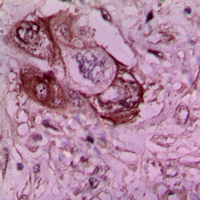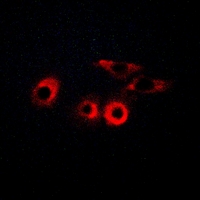Description:Rabbit polyclonal antibody to Laminin gamma 1Immunogen:KLH-conjugated synthetic peptide encompassing a sequence within the C-term region of human Laminin gamma 1. The exact sequence is proprietary.Purification:The antibody was purified by immunogen affinity chromatography.Clonality:PolyclonalForm:Liquid in 0.42% Potassium phosphate, 0.87% Sodium chloride, pH 7.3, 30% glycerol, and 0.01% sodium azide.Dilution:WB (1/500 - 1/1000), IH (1/50 - 1/100), IF/IC (1/50 - 1/200)Gene Symbol:LAMC1Alternative Names:LAMB2; Laminin subunit gamma-1; Laminin B2 chain; Laminin-1 subunit gamma; Laminin-10 subunit gamma; Laminin-11 subunit gamma; Laminin-2 subunit gamma; Laminin-3 subunit gamma; Laminin-4 subunit gamma; Laminin-6 subunit gamma; Laminin-7 subunit gamma; Laminin-8 subunit gamma; Laminin-9 subunit gamma; S-laminin subunit gamma; S-LAM gamma
Entrez Gene (Human):
3915;
SwissProt (Human):
P11047;
SwissProt (Mouse):
P02468;
Storage/Stability:Shipped at 4°C. Upon delivery aliquot and store at -20°C for one year. Avoid freeze/thaw cycles.
-
 Western blot analysis of Laminin gamma 1 expression in PC3 (A), COS7 (B) whole cell lysates. (Predicted band size: 177 kD; Observed band size: 177 kD)
Western blot analysis of Laminin gamma 1 expression in PC3 (A), COS7 (B) whole cell lysates. (Predicted band size: 177 kD; Observed band size: 177 kD) -
 Immunohistochemical analysis of Laminin gamma 1 staining in human breast cancer formalin fixed paraffin embedded tissue section. The section was pre-treated using heat mediated antigen retrieval with sodium citrate buffer (pH 6.0). The section was then incubated with the antibody at room temperature and detected using an HRP conjugated compact polymer system. DAB was used as the chromogen. The section was then counterstained with haematoxylin and mounted with DPX.
Immunohistochemical analysis of Laminin gamma 1 staining in human breast cancer formalin fixed paraffin embedded tissue section. The section was pre-treated using heat mediated antigen retrieval with sodium citrate buffer (pH 6.0). The section was then incubated with the antibody at room temperature and detected using an HRP conjugated compact polymer system. DAB was used as the chromogen. The section was then counterstained with haematoxylin and mounted with DPX. -
 Immunofluorescent analysis of Laminin gamma 1 staining in HepG2 cells. Formalin-fixed cells were permeabilized with 0.1% Triton X-100 in TBS for 5-10 minutes and blocked with 3% BSA-PBS for 30 minutes at room temperature. Cells were probed with the primary antibody in 3% BSA-PBS and incubated overnight at 4 °C in a hidified chamber. Cells were washed with PBST and incubated with a AF594-conjugated secondary antibody (red) in PBS at room temperature in the dark.
Immunofluorescent analysis of Laminin gamma 1 staining in HepG2 cells. Formalin-fixed cells were permeabilized with 0.1% Triton X-100 in TBS for 5-10 minutes and blocked with 3% BSA-PBS for 30 minutes at room temperature. Cells were probed with the primary antibody in 3% BSA-PBS and incubated overnight at 4 °C in a hidified chamber. Cells were washed with PBST and incubated with a AF594-conjugated secondary antibody (red) in PBS at room temperature in the dark.
Genome-wide Runx2 occupancy in prostate cancer cells suggests a role in regulating secretion


 Datasheet
Datasheet MSDS
MSDS